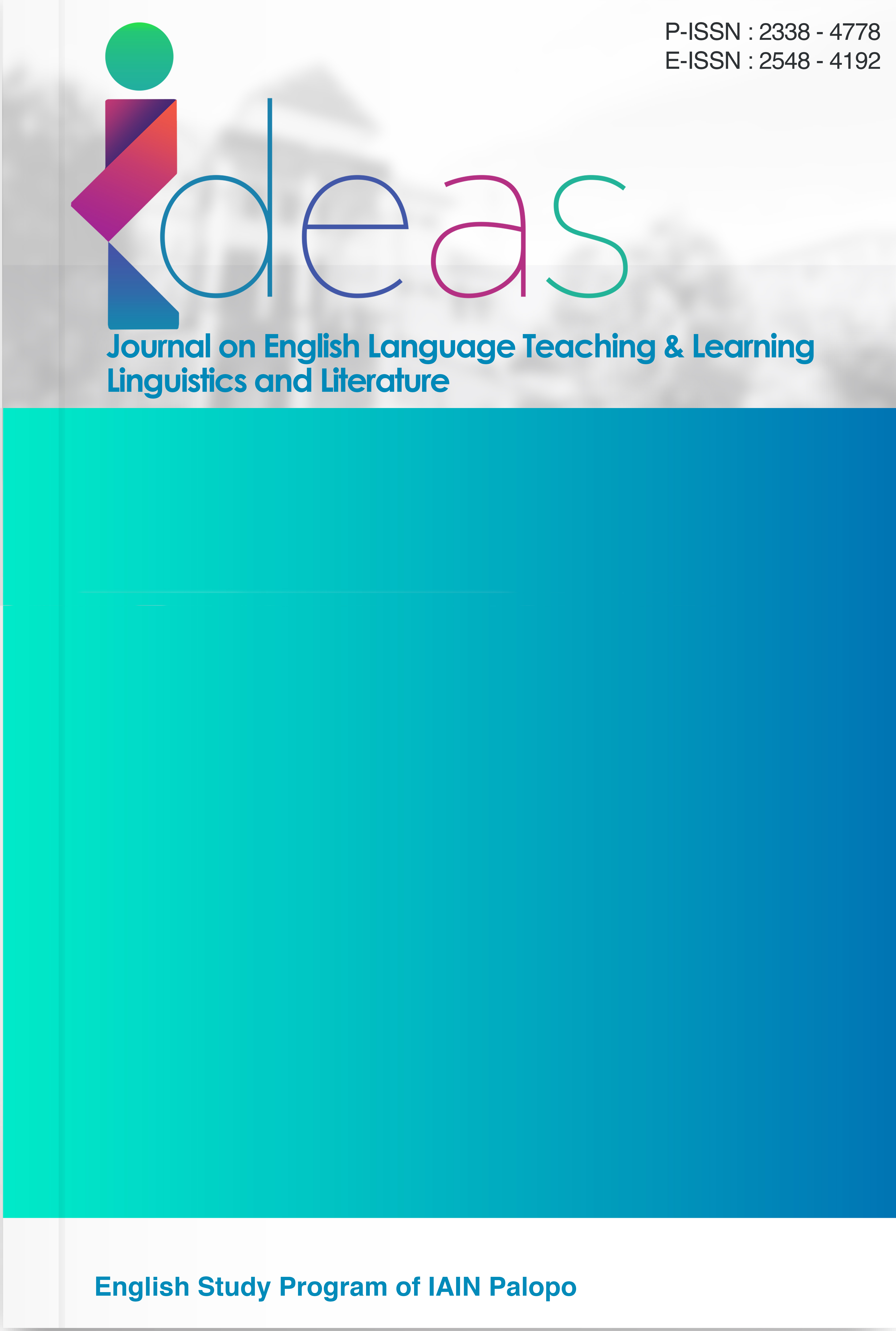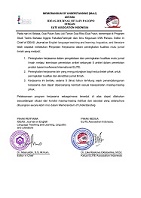Investigating Cognitive Levels on Reading Comprehension Questions in EFL Textbook for Merdeka Curriculum
DOI:
https://doi.org/10.24256/ideas.v13i2.5918Keywords:
EFL textbook, Reading comprehension questions, Revised Bloom's TaxonomyAbstract
This research aims to examine the cognitive levels present in “Bahasa Inggris Work in Progress Buku Siswa Untuk SMA/SMK/MA Kelas 10.” It evaluates how they might influence the development of students' thinking skills. The study employed qualitative content analysis, using an analytical framework adapted from the revised Bloom’s Taxonomy to analyze 35 WH-questions from six selected chapters. This research primarily employed WH-questions as the primary data source, as they are highly valuable for promoting students' literal comprehension skills, rearranging text information, and developing evaluations, personal responses, and predictions. This research found that higher-order thinking skills (HOTS) were more dominant than lower-order thinking skills (LOTS) in the WH-questions. Furthermore, not all six levels of Bloom’s Taxonomy were represented. The cognitive level “Understand” becomes the most dominant in the textbook, followed by “Evaluate,” “Analyze,” and “Remember,” which are the least dominant cognitive levels found in the data. Conversely, the cognitive levels “Apply” and “Create” were not found in the examined data. These results suggest that while the textbook effectively promotes certain aspects of higher-order thinking, it lacks diversity in cognitive challenges. Therefore, teachers are encouraged to supplement the textbook with additional tasks that foster real-world application and creativity. Textbook designers should also integrate a broader range of cognitive levels to provide more comprehensive and balanced learning experiences aligned with the goals of the Merdeka Curriculum.
References
Anderson, L. W., Krathwohl, D., Airasian, P., Cruikshank, K. A., Mayer, R. E., Pintrich, P., Raths, J., & Wittrock, M. C. (Eds.). (2001). A Taxonomy for Learning, Teaching, and Assessing: A Revision of Bloom’s Taxonomy of Educational Objectives. Longman. https://books.google.co.id/books?id=EMQlAQAAIAAJ
Ariawan, S., Kholidi, M. A., & Putra, M. (2023). The Level of Thinking Skills in the Reading Section of EFL Textbooks in Indonesia. Voices of English Language Education Society, 7(1 SE-Articles), 117–125. https://doi.org/10.29408/veles.v7i1.7672
Bloom, B. S., & Krathwohl, D. R. (1956). Taxonomy of Educational Objectives: The Classification of Educational Goals (Issue v. 1). Longmans, Green. https://books.google.co.id/books?id=hos6AAAAIAAJ
Creswell, J. W. (2013). Qualitative Inquiry and Research Design: Choosing Among Five Approaches. SAGE Publications, Inc. https://books.google.co.id/books?id=Ykruxor10cYC
Day, R. R., & Park, J. (2005). Developing Reading Comprehension Questions. Reading in a Foreign Language, 17(1), 60–73.
Dewayani, G. P., Ngadiso, N., & Sarosa, T. (2020). Insufficient Higher-Order Thinking Skills in Reading Comprehension Exercises of an English Language Textbook. ELT Worldwide: Journal of English Language Teaching, 7(2), 125. https://doi.org/10.26858/eltww.v7i2.14476
Drisko, J. W., & Maschi, T. (2016). Content analysis. Oxford University Press, USA.
Erdiana, N., & Panjaitan, S. (2023). How is HOTS integrated into the Indonesian high school English textbook? Studies in English Language and Education, 10(1), 60–77. https://doi.org/10.24815/siele.v10i1.26052
Hussein, J. W. (2006). Hopes and challenges in using action research: the outcome of attempting to help in‐service teachers learn how to design, evaluate, and use reading comprehension questions collaboratively. Educational Action Research, 14(3), 377–393. https://doi.org/10.1080/09650790600847677
Krippendorff, K. (2004). Content Analysis: An Introduction to Its Methodology. SAGE Publications, Inc. https://doi.org/10.4135/9781071878781
Lim, C. K., Eng, L. S., Mohamed, A. R., & Mohamed Ismail, S. A. M. (2018). Relooking at the ESL Reading Comprehension Assessment for Malaysian Primary Schools. English Language Teaching, 11(7), 146. https://doi.org/10.5539/elt.v11n7p146
Maley, A. (2011). Squaring the circle—reconciling materials as constraint with materials as empowerment. In B. Tomlinson (Ed.), Materials Development in Language Teaching (2nd ed., pp. 379–402). Cambridge University Press. https://doi.org/DOI: 10.1017/9781139042789.020
Margana, M., & Widyantoro, A. (2017). Developing English Textbooks Oriented to Higher Order Thinking Skills for Students of Vocational High Schools in Yogyakarta. Journal of Language Teaching and Research, 8(1), 26. https://doi.org/10.17507/jltr.0801.04
Marmolejo-Ramos, F., Miller, J., & Habel, C. (2014). The influence of question type, text availability, answer confidence, and language background on student comprehension of an expository text. Higher Education Research & Development, 33(4), 712–727. https://doi.org/10.1080/07294360.2013.863841
Miles, M. B., & Huberman, A. M. (1994). Qualitative data analysis: An expanded sourcebook, 2nd ed. In Qualitative data analysis: An expanded sourcebook, 2nd ed. SAGE Publications, Inc.
Mishan, F., & Timmis, I. (2015). Materials Development for TESOL. Edinburgh University Press. https://doi.org/10.1515/9780748691371
Newmann, F. M. (1990). Higher order thinking in teaching social studies: a rationale for the assessment of classroom thoughtfulness. Journal of Curriculum Studies, 22(1), 41–56. https://doi.org/10.1080/0022027900220103
OECD. (2023a). PISA 2022 Results (Volume I). OECD. https://doi.org/10.1787/53f23881-en
OECD. (2023b). PISA 2022 Results (Volume II). OECD. https://doi.org/10.1787/a97db61c-en
Poedjiastutie, D. (2018). Indonesian School Students' Reading Habits: A Sociocultural Perspective. International Journal of English Language and Literature Studies, 7(4), 94–100. https://doi.org/10.18488/journal.23.2018.74.94.100
Rianto, A. (2021). Examining gender differences in reading strategies, reading skills, and English proficiency of EFL university students. Cogent Education, 8(1). https://doi.org/10.1080/2331186X.2021.1993531
Saldaña, J. (2009). The Coding Manual for Qualitative Researchers. In The coding manual for qualitative researchers. Sage Publications Ltd.
Sari, R. N., & Sakhiyya, Z. (2020). The textbook analysis on students’ books of the Symphony 1 English course book for Senior High School Grade X viewed from higher-order thinking skills. ELT Forum: Journal of English Language Teaching, 9(2), 97–106. https://doi.org/10.15294/elt.v9i2.38711
Schreier, M. (2012). Qualitative Content Analysis in Practice. SAGE Publications Ltd. https://doi.org/10.4135/9781529682571
Shuyi, N. S., & Renandya, W. (2019). An analysis of the cognitive rigor of questions used in secondary school English language textbooks in Singapore. Asian Journal of English Language Studies, 7, 172–190. https://doi.org/10.59960/7.a8
Suyadi, S., & Aisyah, S. (2023). Textbook Evaluation: A Framework for Evaluating the English Subject in Kurikulum Merdeka for the Tenth Grade. Jurnal Ilmiah Universitas Batanghari Jambi, 23(3), 2695. https://doi.org/10.33087/jiubj.v23i3.4551
The Partnership for 21st Century Skills. (2009). Framework for 21st Century Learning Definitions.
Ur, P. (2024). A Course in English Language Teaching. Cambridge University Press. https://doi.org/10.1017/9781009417594
Xie, J., Xie, J., & Bui, G. (2024). A diachronic study of authorial stance in the discussion of Chinese MA theses and published research articles. Journal of English for Academic Purposes, 67, 101320. https://doi.org/10.1016/j.jeap.2023.101320
Xie, S. (2024). An Analysis of the Cognitive Demands of Senior High School English as a Foreign Language Textbooks in China. Sage Open, 14(3). https://doi.org/10.1177/21582440241280457
Downloads
Published
Issue
Section
Citation Check
License
Copyright (c) 2025 Atina Firdausa Qisthi, Djatmika, Ngadiso

This work is licensed under a Creative Commons Attribution-ShareAlike 4.0 International License.
Authors retain copyright and grant the journal right of first publication with the work simultaneously licensed under an Attribution-ShareAlike 4.0 International (CC BY-SA 4.0) that allows others to share the work with an acknowledgement of the work's authorship and initial publication in this journal.
Authors are able to enter into separate, additional contractual arrangements for the non-exclusive distribution of the journal's published version of the work (e.g., post it to an institutional repository or publish it in a book), with an acknowledgement of its initial publication in this journal.
Authors are permitted and encouraged to post their work online (e.g., in institutional repositories or on their website) prior to and during the submission process, as it can lead to productive exchanges, as well as earlier and greater citation of published work (See the Effect of Open Access)




